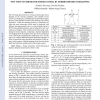Free Online Productivity Tools
i2Speak
i2Symbol
i2OCR
iTex2Img
iWeb2Print
iWeb2Shot
i2Type
iPdf2Split
iPdf2Merge
i2Bopomofo
i2Arabic
i2Style
i2Image
i2PDF
iLatex2Rtf
Sci2ools
ICIP
2010
IEEE
2010
IEEE
New view synthesis for stereo cinema by hybrid disparity remapping
The 3-D shape perceived from viewing a stereoscopic movie depends on the viewing conditions, most notably on the screen size and distance, and depth and size distortions appear because of the differences between the shooting and viewing geometries. When the shooting geometry is constrained, or when the same stereoscopic movie must be displayed with different viewing geometries (e.g. in a movie theater and on a 3DTV), these depth distortions may be reduced by new view synthesis techniques. They usually involve three steps: computing the stereo disparity, computing a disparity-dependent 2-D mapping from the original stereo pair to the synthesized views, and finally composing the synthesized views. In this paper, we compare different disparity-dependent mappings in terms of perceived shape distortion and alteration of the images, and we propose a hybrid mapping which does not distort depth and minimizes modifications of the image content.
| Added | 12 Feb 2011 |
| Updated | 12 Feb 2011 |
| Type | Journal |
| Year | 2010 |
| Where | ICIP |
| Authors | Frederic Devernay, Sylvain Duchêne |
Comments (0)

